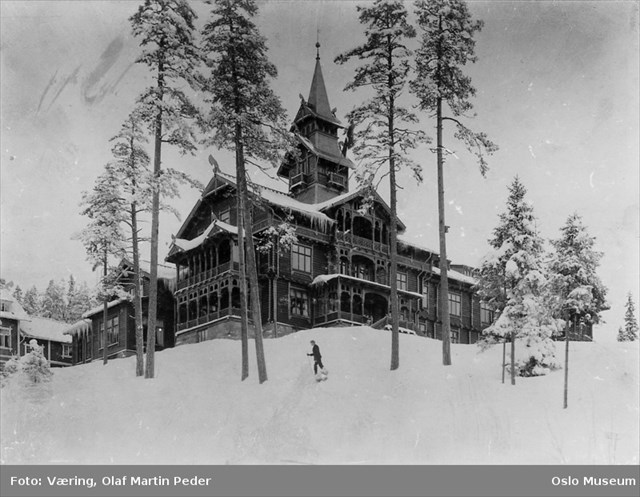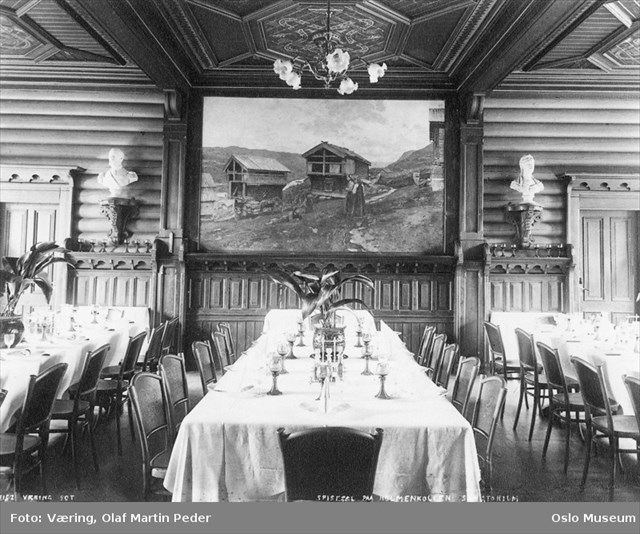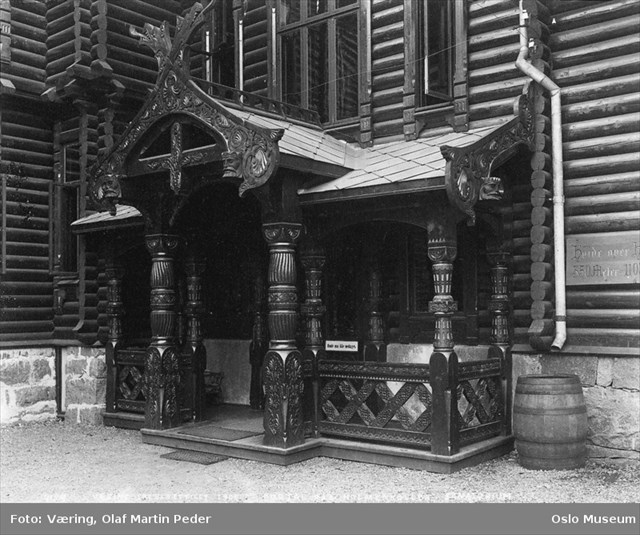Holmenkollen Sanatorium Traditional Geocache
Prancin'pig Potter: Sorry, haven't been able to spare time for maintenance. I archive this today and will remove the cache tomorrow.
-
Difficulty:
-

-
Terrain:
-

Size:  (regular)
(regular)
Please note Use of geocaching.com services is subject to the terms and conditions
in our disclaimer.
Mens handlestria og industri regjerer nede i byen, hviler denne cachen opp i frisk luft ute i landlige omgivelser hvor alt er lagt til rette for helsebringende ro og rehabiliterende trening. While the business, industry and shopping bustle rules downtown, this cache rests out above it all in a rural setting of fresh air where plenty of opportunity for healthy relaxation and physical rehabilitation is available.

Holmenkollen Sanatorium (Creative Commons Lisens)
Norsk
Begrepet: Sanatorium er en eldre betegnelse på et helsehjem, kursted, rekreasjonssted og en klinikk for langtidsbehandling. Begrepet har sin opprinnelse fra det latinske ordet «sanare» hvilket betyr å helbrede eller gjøre frisk igjen, og ble særlig benyttet i Norge og andre land om institusjoner for behandling av personer med tuberkulose. Sanatoriene hadde sin glanstid før antibiotikaens tid. Den tyske legen Herrmann Brehmer hevdet i 1853 at den alvorlige lungesykdommen tuberkulose kunne helbredes, og åpnet i 1863 det første sanatoriet, Brehmerschen Heilanstalt für Lungenkranke in Görbersdorf, Sokołowsko i Polen. Behandlingen måtte starte tidlig etter sykdomsutbruddet, pasientene skulle være i frisk luft og landlige omgivelser, spise næringsrik mat, ha mye ro og hvile, og drive forsiktig trening. Rasjonalet var at pasienters immunforsvar ville styrkes, og dermed i større grad være i stand til overvinne pulmonologiske tuberkuløse infeksjoner. Tuberkulose-sanatorier ble vanlige over hele Europa fra slutten av 1800-tallet og frem til effektive medisiner ble oppdaget (Wikipedia).
Historien bak Holmenkollen Sanatorium
“… I 1888 opprettet (Dr. Ingebrigt Christian Lund) Holm sammen med bl.a. veidirektør Hans H. Krag og borgermester Evald Rygh Selskabet for Anlæggene paa Holmen- og Voxenkollen. Selskapets formål var å utnytte de store uutbygde arealene i åssiden nordvest for byen, dels til hoteller og kuranstalter, dels til boliger – og det så snart områdene ble lett tilgjengelige gjennom byggingen av en forstadsbane, Holmenkolbanen. Det begynte 1889 med “Peisestuen” ved Besserudtjernet og Holmenkollen Turisthotel, en stor laftet bygning i dragestil, tegnet av arkitekt Holm Munthe. Hotellet ble ødelagt av brann 1895 og gjenoppført året etter, denne gang etter tegninger av Ole Sverre og med innvendige utsmykninger av Theodor Kittelsen og Gerhard Munthe. Men også denne hotellbygningen ble ødelagt av brann (1914). I mellomtiden hadde dr. Holm reist en kurbadbygning, “Midtstuen”, like bak hotellet og senere (1894) Holmenkollen Sanatorium ovenfor denne; “Sportsstuen” (nå Holmenkollen Restaurant) ble reist omtrent samtidig. Etter den siste brannen overtok sanatoriet turisthotellets funksjoner, og bygningen utgjør i dag kjernen i Holmenkollen Park Hotel Rica.” (Store Norske Leksikon)
Arkitekturen
”Balthazar Conrad Lange 1854-1937 Balthazar Lange vant konkurransen om å tegne Holmenkollen Sanatorium. Bygget ble et av hovedverkene i norsk dragestil arkitektur.” ”Gerhard Munthe (1849-1929) var først og fremst kunstner, men en viktig del av hans kunstvirke var dekorarbeid, - er arbeid som var mer og mer fokusert på å jobbe frem en særnorsk dekorstil. Denne stilen hadde innslag av norrøne symboler, eventyr og sagn, men også sterkt inspirert av jugendstilen. Munthe var sterkt delaktig i dekoren av både Holmenkollen Turisthotell med bl.a. det kjente Eventyrrommet samt Holmenkollen Sanatorium. Tak, vegger og interiør er preget av utskjæringer som ble en betydningsfull del av norske dekor for en periode. I Oscarstuen i Restaurant De Fem Stuer finnes de originale takdekorasjonene av Gerhard Munthe.”(www.holmenkollenparkhotell.no) ”Dragestil 1880–1910 Den har røtter i nasjonalromantikken og J. C. Dahls arbeid med å bevare stavkirkene. På denne tiden ble også Tuneskipet, Gokstadskipet og Osebergskipet gravet ut. … Inspirasjonen kom fra stavkirker og ornamentikk som var beslektet med denne… Motivene med ranker og drager ble laget fritt etter fantasien. En plasserte dragehoder på gavlspisser slik en finner på noen av stavkirkene. Bygningsformer ble hentet fra bygninger på gårdene særlig loftsbygninger og stabbur. … Bygningene hadde også balkonger med rundbuer, fremspringende annenetasjer og lave gavler. Balkongene og rundbuene ble fylt med et sveitsisk inspirert system med krysstilte avstiver og en lar gavlen stikke langt utenfor veggen slik en finner det i sveitserstilen. I tillegg fra sveitserstilen tok det opp trekk som høy grunnmur, ofte i naturstein, usymmetrisk grunnplan og bruk av motiver på svalen og gavlen. Konstruksjonen var en blanding av laft og stavteknikk." (kunsthistorie.com)
Cachen
Denne skogscachen er lett å få øye på, men litt vandring utenfor stien kreves. Kle dere etter værforholdet. En lett start på turen er å følge stien fra hotellets parkeringshus til enden av hotellets nettingsgjerde. Deretter følg langs UTSIDEN av gjerdet opp i skogen i retning NØ, slik at du kommer ovenfor bekken. Så vend cirka nordover. Bruk GPS nå. Plastboksen er en kamuflert 1 ½ L. lock & lock.

Spisesal paa Holmenkollens Sanatorium (Creative Commons Lisens)

Portal paa Holmenkollen Sanatorium (Creative Commons Lisens)
English (Google and I translated)
Sanatorium is an older term for a medical institution, or health resort, designated for long-term treatment. The term originated from the Latin word "Sanare" which means to heal or do well again, and was a title extensively used in Norway and other countries for facilities for the treatment of tuberculosis. Sanatoriums had their heyday before the time of antibiotics. The German doctor Herrmann Brehmer claimed in 1853 that the severe lung disease tuberculosis could be cured and in 1863 opened the first sanatorium: Brehmerschen Heilanstalt für Lungenkranke in Görbersdorf, Sokołowsko in Poland. The treatment had to start early after disease onset. Patients should be in the fresh air and countryside, eating nutritious food, resting extensively, and partaking in careful training. The rationale was that the patients' immune systems would be strengthened and thus they would be more likely able to overcome pulmonary tuberculosis infections. Tuberculosis sanatoriums became common throughout Europe from the late 1800s until effective drugs were discovered. (Wikipedia)
The History behind Holmenkollen Sanatorium
“… In 1888 Dr. Ingebrigt Christian Lund Holm created, together with others, such as Director of Road Construction Hans H Krag and Mayor Evald Rygh, the Society for the Development of Holmenkollen and Voksenkollen. The company’s purpose was to utilize the large undeveloped areas on the hillside northwest of the city, partly for hotels and sanatoriums and partly for housing. This would start just as soon as these areas were made easily accessible due to the building of the suburban rail line: Holmenkolbanen. It all began in 1889 with “Peisestuen/The Lodge” at Besserud pond and with Holmenkollen Tourist Hotel, a large log building in Dragon style drawn by the architect Holm Munthe. The hotel was ruined by fire in 1895 and rebuilt the following year, this time using architectural drawings by Ole Sverre and with interior decorations by Theodor Kittelsen and Gerhard Munthe. This hotel was also ruined by fire (1914). In the meantime, Dr. Holm had raised a spa called Midtstuen just behind the hotel and later (1894) Holmenkollen Sanatorium above this. Sportsstuen/Sports’ lounge, (now Holmenkollen Restaurant) was built simultaneously. After the second hotel fire, the sanatorium took over the burnt tourist hotel’s services and that sanatorium building of 1894 is today the core of Holmenkollen Park Hotel Rica.” (Store Norske Leksikon: http://snl.no/.nbl_biografi/Ingebrigt_Holm/utdypning)
The Architecture
“Balthazar Conrad Lange 1854-1937: Balthazar Lange won the architectural design competition for Holmenkollen Sanatorium. The building became one of the principal works of Norwegian Dragon style Architecture. …Gerhard Munthe (1849-1929) was first and foremost a painter and illustrator, but another important part of his art was decorative work - work that was more and more focused on developing a uniquely Norwegian décor style. This style had elements of Norse symbols, fairytales and legends, but was also strongly inspired by Art Nouveau. Munthe was highly involved in the decoration of both Holmenkollen Tourist Hotel with its famous Fairytale room and with Holmenkollen Sanatorium. Ceilings and walls in what is now Holmenkollen Park Hotel are characterized by carvings which became a meaningful part of Norwegian décor for the period. In Oscarstuen today, in the restaurant De Fem Stuer/The Five Rooms, are original ceiling ornamentations by Gerhard Munthe.” (www.holmenkollenparkhotell.no) ”Dragestil/Dragon Style 1880-1910 has its roots in the Norwegian National Romantic period and in J.C. Dahl’s work to preserve the stave churches. At this time the Viking ships from Tune Herred, Gokstad and Oseberg were excavated. … Inspiration for the Dragon style came from stave churches and related ornamentation … motifs with vines and dragons were pulled freely from the imagination. One placed dragon heads on gables as one had found
them on some of the stave churches. The building techniques were gathered from the farms, especially from log buildings and the log stabbur/store houses. The buildings had balconies and arches, large second stories that stuck out and low gables. The balconies and arches were filled with a Swiss inspired system of cross-supports and gables that stick a long way out from the wall. In addition the Dragon Style pulled features from The Swiss Style such as high foundations, often in rock, asymmetrical floor plans, and use of motifs on the gallery and the gable. Construction was a blend of stave and notched-log technique. “(kunsthistorie.com)
The Cache
This woodsy cache is easy to spy, but requires a bit of off-trail maneuvering. Dress for the weather conditions. For an easy route to the cache, take the trail that begins at the hotel’s parking garage until you reach the end of the hotel’s chain-link fence. Then follow along the OUTSIDE of the fence up to the eastnortheast until you are above the stream. Then head basically north. Use your GPS. The plastic box is a camouflaged 1 ½ liter Lock and Lock.

Holmenkollen Sanatorium Station, Tryvandsbanen (Creative Commons Lisens)
Additional Hints
(No hints available.)